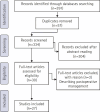Postoperative conditions of rehabilitative interest in lung transplantation: a systematic review
- PMID: 39169532
- PMCID: PMC11534411
- DOI: 10.12701/jyms.2024.00521
Postoperative conditions of rehabilitative interest in lung transplantation: a systematic review
Abstract
Lung transplantation is an elective treatment option for end-stage respiratory diseases in which all medical therapy options have been exhausted. The current study aimed to identify updated information on the postoperative conditions that may impair rehabilitation after lung transplantation and to provide specific considerations of their clinical relevance during the recovery process. The present study is a systematic review conducted by searching three primary databases: the United States National Library of Medicine PubMed system, Scopus, and the Cochrane Library. The databases were searched for articles published from database inception until May 2024; at the end of the selection process, 27 documents were included in the final analysis. The retrieved material identified 19 conditions of rehabilitative interest that potentially affect the postoperative course: graft dysfunction, dysphagia, postsurgical pain, cognitive impairment, chronic lung allograft dysfunction-bronchiolitis obliterans syndrome, phrenic nerve injury, delayed extracorporeal membrane oxygenation weaning, airway clearance, refractory hypoxemia, mediastinitis, reduced oxidative capacity, sternal dehiscence, coronavirus disease 2019 (COVID-19), gastroparesis, ossification of the elbow, Takotsubo cardiomyopathy, airway dehiscence, recurrent pleural effusion, and scapular prolapse. Although some patients are not amenable to rehabilitation techniques, others can significantly improve with rehabilitation.
Keywords: Lung transplantation; Physiotherapy; Postoperative complications; Rehabilitation; Systematic review; Treatment outcome.
Conflict of interest statement
No potential conflict of interest relevant to this article was reported.
Figures




References
-
- Egan TM, Westerman JH, Lambert CJ, Detterbeck FC, Thompson JT, Mill MR, et al. Isolated lung transplantation for end-stage lung disease: a viable therapy. Ann Thorac Surg. 1992;53:590–6. - PubMed
-
- Mendeloff EN. Lung transplantation for cystic fibrosis. Semin Thorac Cardiovasc Surg. 1998;10:202–12. - PubMed
-
- Marulli G, Rea F. Lung transplantation for emphysema. Transplant Proc. 2008;40:2006–9. - PubMed
-
- Pirson J, Duysinx B, Nguyen D, Corhay JL, Louis R. Lung transplantation benefits for terminal lung diseases. Rev Med Liege. 2011;66:434–9. - PubMed
LinkOut - more resources
Full Text Sources

